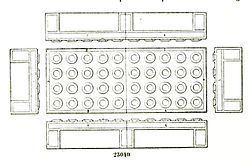Predecessor Iufni Children Renseneb | Parents Sekhemkare | |
 | ||
Reign 1788–1785 BC, c. 1740 BC (Thirteenth Dynasty of Egypt) Successor Semenkare Nebnuni (Ryholt, Franke) Father uncertain, possibly Sekhemkare Amenemhat V | ||
Seankhibre Ameny Antef Amenemhet VI was an Egyptian pharaoh of the early Thirteenth Dynasty ruling in the first half of the 18th century BC during a time referred to as the late Middle Kingdom or early Second Intermediate Period, depending on the scholar. Amenemhat VI certainly enjoyed a short reign, estimated to 3 years or shorter. He is attested by a few contemporary artefacts and is listed on two different king lists. He may belong to a larger family of pharaohs including Amenemhat V, Ameny Qemau, Hotepibre Qemau Siharnedjheritef and Iufni.
Contents
Attestations
Amenemhat VI is listed on the Turin canon, a king list redacted in the early Ramesside period and which serves as the primary historical source regarding the Second Intermediate Period. In the latest reading of the canon by the Danish Egyptologist Kim Ryholt, Amenemhat VI appears in the 7th column, 10th row under his prenomen Seankhibre. This corresponds to the 6th column, 10th row in Alan Gardiner's and Jürgen von Beckerath's reading of the Turin king list.
Amenemhat VI is also mentioned on the Karnak king list, entry 37.
Amenemhat VI is attested by a few contemporary artefacts. These include 2 cylinder seals from el-Mahamid el-Qibli in Upper Egypt, one of which is dedicated to "Sobek Lord of Semenu". An offering table bearing Amenemhat VI's cartouche has been discovered in Karnak and is now in the Egyptian Museum, CG 23040. Also inscribed with the cartouches of Amenemhat is a stele from Abydos and an architrave from a private tomb of the necropolis of Heliopolis However, recent research indicates that the latter monument belongs to another king, Seankhibtawy Seankhibra.
Chronology
The relative chronological position of Amenemhat VI is secured thanks to the Turin canon. His predecessor was a poorly known pharaoh named Iufni and his successor was an equally obscure king, Semenkare Nebnuni.
The absolute chronological position of Amenemhat VI is less certain owing to uncertainties affecting the earlier kings of the dynasty. According to Kim Ryholt and Darrell Baker, he was the 8th king of the dynasty, whereas Thomas Schneider, Detlef Franke and von Beckerath see him as the 7th ruler.
The duration of Amenemhat's reign is lost due to the poor state of preservation of the Turin papyrus and only the number of days is readable as [...] and 23 days. Ryholt nonetheless assigns him a short reign of 3 years spanning 1788–1785 BC.
Extent of rule
It is unclear whether or not Amenemhat VI reigned over the whole of Egypt. He likely had control over Lower Nubia, which had been conquered by the 12th Dynasty and would not be abandoned before at least another 60 years. His control over Lower Egypt is debated. Ryholt believes that the Canaanite 14th Dynasty was already in existence at the time, forming an independent realm controlling at least the Eastern Nile Delta. While this analysis is accepted by some scholars—among them, Gae Callender, Janine Bourriau and Darrell Baker, it is rejected by others including Manfred Bietak, Daphna Ben-Tor and James and Susan Allen who contend that the 14th Dynasty could not have existed before the later king of the 13th Dynasty Sobekhotep IV.
Family
The Egyptologist Kim Ryholt proposes that Amenemhat VI was a member of a larger royal family including pharaohs Sekhemkare Amenemhat V, Ameny Qemau, Hotepibre Qemau Siharnedjheritef and Iufni. He bases this conclusion on the double names borne by these pharaohs, which he believes are filiative nomina, i.e. names referring to one's parents. Hence the Ameny in Ameny Qemau would indicate that he was the son of Amenemhat V, then succeeded by his own son Hotepibre Qemau Siharnedjheritef as shown by the Qemau in his name. Similarly "Ameny Antef Amenemhat (VI)" would be a triple name meaning "Amenemhat, son of Antef, son of Ameny" possibly because his father was a certain "King's son Antef" attested on scarab seals dated on stylistic ground to the 13th Dynasty and who would himself be a son of Amenemhat V. Amenemhat VI's predecessor Iufni would also be part of this family although his precise relation to the other members cannot be settled due to the lack of material dating to his very short reign.
Less than 10 years after Amenemhat VI's reign, a king named Renseneb Amenemhat took the throne. Following the same logic, he would be a son of a king Amenemhat who could possibly be Amenemhat VI or one of the intervening kings. Ryholt's analysis is contested by some Egyptologists as it relies on the unproven assumption that double names are necessarily filiative nomina.
